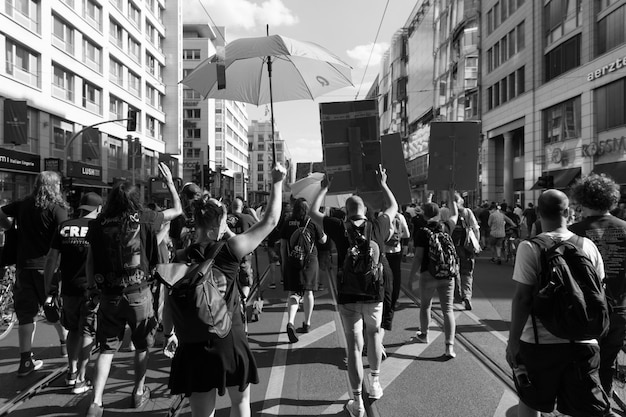Effective Strategies to Combat Systemic Racism in US Criminal Justice

Effective strategies for addressing systemic racism in the US criminal justice system involve comprehensive criminal justice reform, policy changes, community engagement and empowerment, education and awareness programs, and promoting restorative justice practices.
Addressing what are the most effective strategies for addressing systemic racism in the US criminal justice system? requires a multifaceted approach targeting the deep-rooted biases and inequalities embedded within the system.
Understanding Systemic Racism in Criminal Justice
Systemic racism in the US criminal justice system refers to the embedded and pervasive biases, policies, and practices that disproportionately affect people of color at every stage of the legal process. This includes policing, arrests, sentencing, and incarceration.
Understanding the historical context and current manifestations of systemic racism is crucial for developing effective strategies to dismantle it and create a more equitable system.
Historical Roots of Systemic Racism
The roots of systemic racism in the US criminal justice system can be traced back to slavery, Jim Crow laws, and other forms of legal and social discrimination. These historical injustices have created a foundation of inequality that continues to impact communities of color.
Current Manifestations of Systemic Racism
Today, systemic racism manifests in various ways, including racial profiling, disproportionate sentencing for similar crimes, and unequal access to legal representation. These issues contribute to higher rates of incarceration for people of color.

- Racial Profiling: Law enforcement officers disproportionately target people of color based on stereotypes and biases.
- Sentencing Disparities: People of color often receive harsher sentences for the same crimes compared to their white counterparts.
- Unequal Access to Justice: Lack of resources and inadequate legal representation further disadvantage communities of color.
Addressing these manifestations requires a comprehensive understanding of the historical context, a commitment to data-driven solutions, and a willingness to challenge and change existing policies and practices.
Comprehensive Criminal Justice Reform
Comprehensive criminal justice reform involves enacting policies and legislative changes at the federal, state, and local levels to address the root causes of systemic racism and promote fairness and equity. This includes reforming sentencing laws, reducing mandatory minimums, and investing in alternatives to incarceration.
These reforms aim to reduce disparities and create a more just and equitable system for all.
Sentencing Reform
Sentencing reform seeks to reduce disparities in sentencing by eliminating mandatory minimums, repealing “three strikes” laws, and adopting evidence-based sentencing guidelines that prioritize rehabilitation and treatment over incarceration.
Alternatives to Incarceration
Investing in alternatives to incarceration, such as drug treatment programs, mental health services, and community-based rehabilitation programs, can reduce reliance on imprisonment and address the underlying issues that contribute to criminal behavior.
- Drug Treatment Programs: Providing access to effective drug treatment can reduce recidivism rates and improve public safety.
- Mental Health Services: Addressing mental health issues can prevent individuals from entering the criminal justice system and provide them with the support they need to lead productive lives.
- Community-Based Rehabilitation: These programs offer support, resources, and guidance to help individuals successfully reintegrate into society after incarceration.
Comprehensive criminal justice reform requires a commitment to data-driven solutions, a willingness to challenge existing policies and practices, and a focus on promoting rehabilitation and restorative justice.
Policy Changes to Address Disparities
Policy changes are essential for addressing disparities within the criminal justice system. These changes entail reforming policing practices, implementing data collection and transparency measures, and promoting accountability for misconduct.
Such policies create a fairer and more equitable system, protecting the rights of all individuals.

Reforming Policing Practices
Reforming policing practices involves implementing policies that promote de-escalation techniques, implicit bias training, and community policing strategies. These efforts can reduce instances of excessive force and improve relationships between law enforcement and the communities they serve.
Data Collection and Transparency
Implementing data collection and transparency measures allows for the identification of racial disparities in arrests, sentencing, and other areas of the criminal justice system. This data can be used to inform policy changes and promote accountability.
- Body Cameras: Equipping law enforcement officers with body cameras can increase transparency and accountability.
- Data Analysis: Analyzing data on arrests, sentencing, and incarceration rates can reveal patterns of racial bias.
- Citizen Review Boards: Establishing citizen review boards can provide independent oversight of law enforcement agencies.
Effective policy changes require a commitment to data-driven solutions, a willingness to engage with community stakeholders, and a focus on promoting fairness and equity in all aspects of the criminal justice system.
Community Engagement and Empowerment
Community engagement and empowerment are fundamental for addressing systemic racism in the criminal justice system. This includes building trust between law enforcement and communities, supporting community-led initiatives, and investing in programs that address the root causes of crime.
These efforts contribute to a more just and equitable system that reflects the needs and values of the community.
Building Trust Between Law Enforcement and Communities
Building trust between law enforcement and communities requires open communication, transparency, and a commitment to addressing past grievances. This can be achieved through community policing initiatives, town hall meetings, and collaborative problem-solving approaches.
Supporting Community-Led Initiatives
By supporting local initiatives that address the root causes of crime, communities can create social and economic opportunities for residents, foster positive youth development, and empower individuals to become active participants in the criminal justice reform process.
These initiatives provide residents with social and economic stability, promoting a safer local environment.
- Neighborhood Watch Programs: Empowering residents to take an active role in crime prevention.
- Community Centers: Providing safe spaces for youth and offering resources and support to families.
- Economic Development Initiatives: Creating job opportunities and promoting economic stability in underserved communities.
Meaningful community engagement and empowerment necessitate a long-term commitment to collaboration, trust-building, and shared decision-making.
Education and Awareness Programs
Education and awareness initiatives are vital for raising public consciousness and fostering a deeper comprehension of systematic racism within the framework of the criminal justice system. These initiatives typically encompass media campaigns, workshops, and training sessions targeted towards various groups, including law enforcement personnel, legal practitioners, and the broader community.
These educational avenues cultivate comprehension and empathy and dismantle biases that perpetuate systemic inequities.
Media Campaigns
Strategically designed media campaigns spotlight the pervasive nature of systemic racism and its far-reaching repercussions on individuals and communities. These campaigns serve to educate the public, engender empathy, and spark dialogue regarding the imperative for reform.
Workshops and Training Sessions
Workshops and training sessions furnish law enforcement officers, legal professionals, and community members with the requisite knowledge and skills to acknowledge and confront biases, refine communication techniques, and embrace equitable practices. These participatory sessions foster inclusivity and accountability.
- Implicit Bias Training: Assisting participants in recognizing and mitigating unconscious biases that may impact decision-making processes.
- Cultural Competency Training: Furnishing individuals with insights into diverse cultural norms and values to enhance interaction and comprehension.
- Community Dialogue Forums: Establishing platforms for open dialogue and exchange between law enforcement and community members to nurture trust and collaboration.
Efficient educational and awareness initiatives mandate sustained investment, collaboration across diverse stakeholders, and dedication to assessing and refining programs in response to evolving dynamics.
Promoting Restorative Justice Practices
Promoting restorative justice practices offers a constructive strategy for addressing the harm resulting from crime and fostering reconciliation among offenders, victims, and communities.
These measures prioritize healing, accountability, and community engagement over punitive measures.
Victim-Offender Dialogue
Victim-offender dialogue furnishes an opportunity for victims to confront offenders, share the impact of the crime, and actively participate in shaping solutions aimed at rectifying the harm caused. These dialogues promote healing, empathy, and accountability.
Community Conferencing
In community conferencing, community members, victims, and offenders converge to collectively address the harm stemming from crime and devise strategies aimed at prevention and resolution. These conferences empower communities to reclaim ownership of justice processes and foster constructive conflict resolution.
- Reparative Agreements: Involve offenders consenting to restitution or community service as a means of recompense for the harm inflicted.
- Support Circles: Encompass community members furnishing support and direction to both offenders and victims throughout the restorative justice procedure.
- Education Programs: Entail imparting knowledge to offenders regarding the impact of their actions on victims and communities to cultivate empathy and accountability.
Successful advancement of restorative justice methodologies necessitates a steadfast dedication to collaboration, inclusivity, and acknowledgment of the diverse needs and viewpoints of all stakeholders concerned.
| Key Point | Brief Description |
|---|---|
| ⚖️ Criminal Justice Reform | Enacting fair policies, reforming sentencing laws, and reducing mandatory minimums. |
| 🤝 Community Engagement | Building trust, supporting local initiatives, and addressing crime’s root causes. |
| 📚 Education & Awareness | Raising awareness, conducting workshops, and training law enforcement. |
| 🔄 Restorative Justice | Promoting healing, dialogue, and community involvement. |
FAQ
Systemic racism refers to the policies and practices that perpetuate racial inequality throughout the criminal justice system, from policing to sentencing.
Community engagement builds trust, fosters collaboration, and ensures that reforms are responsive to the needs and concerns of those most affected by systemic racism.
Examples include victim-offender dialogue, community conferencing, and reparative agreements, all aimed at repairing harm and promoting accountability and healing.
Collecting and analyzing data can reveal patterns of racial bias in the criminal justice system, informing policy changes and promoting accountability for misconduct.
Alternatives like drug treatment and mental health services address underlying issues, reducing reliance on imprisonment and promoting rehabilitation and community reintegration.
Conclusion
Addressing systemic racism in the US criminal justice system requires a multifaceted approach that encompasses comprehensive criminal justice reform, policy changes, community engagement, education and awareness programs, and the promotion of restorative justice practices. By implementing these strategies and working collaboratively, we can strive to create a more equitable and just system for all.





